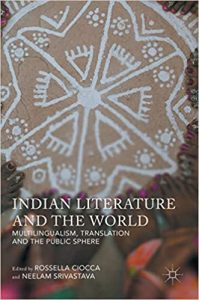Professor Francesca Orsini is the Principal Investigator of the MULOSIGE project, and leader of the North India case study. She is Professor of Hindi and South Asian Literature, as well as Chair of the CCLPS. Her research interests range from modern and contemporary Hindi literature to the multiligual history of literature in early modern North India. Prior to this project, she ran the AHRC-funded “North Indian Literary Culture and History, 1450–1650” (2006–09) and a British Academy-funded international collaboration with SARAI/CSDS on Hinglish (2014–15).
Reading Together: Hindi, Urdu, and English Village Novels
In: Indian Literature and the World: Multilingualism, Translation, and the Public Sphere.
 Indian Literature and the World: Multilingualism, Translation, and the Public Sphere, edited by Rossella Ciocca and Neelam Srivastava is about the most vibrant yet under-studied aspects of Indian writing today.
Indian Literature and the World: Multilingualism, Translation, and the Public Sphere, edited by Rossella Ciocca and Neelam Srivastava is about the most vibrant yet under-studied aspects of Indian writing today.
It examines multilingualism, current debates on postcolonial versus world literature, the impact of translation on an “Indian” literary canon, and Indian authors’ engagement with the public sphere. The essays cover political activism and the North-East Tribal novel; the role of work in the contemporary Indian fictional imaginary; history as felt and reconceived by the acclaimed Hindi author Krishna Sobti; Bombay fictions; the Dalit autobiography in translation and its problematic international success; development, ecocriticism and activist literature; casteism and access to literacy in the South; and gender and diaspora as dominant themes in writing from and about the subcontinent. Troubling Eurocentric genre distinctions and the split between citizen and subject, the collection approaches Indian literature from the perspective of its constant interactions between private and public narratives, thereby proposing a method of reading Indian texts that goes beyond their habitual postcolonial identifications as “national allegories”.
Abstract: Reading Together: Hindi, Urdu, and English Village Novels
Every region of India is and has been multilingual, with speakers of different languages and speakers of multiple languages. But literary ‘multilingual locals’ are often more fragmented than we think. While multilingualism suggests interest, and proficiency, in more than one literary language and tradition, very real barriers exist in terms of written vs. oral access, mutual interaction, and social and cultural hierarchies and exclusions. What does it mean to take multilingualism seriously when studying literature? One way, this essay suggests, is to consider works on a similar topic or milieu written in the different languages and compare both their literary sensibilities and their social imaginings. Rural Awadh offers an excellent example, as the site of many intersecting processes and discourses—of shared Hindu-Muslim sociality and culture and Muslim separatism, of nostalgia for a sophisticated culture and critique of zamindari exploitation and socio-economic backwardness, as the home of Urdu and of rustic Awadhi. This essay analyses three novels written at different times about rural Awadh—one set before 1947 and the others in the wake of the Zamindari Abolition Act of 1950 and the migration of so many Muslim zamindars from Awadh, either to Pakistan or to Indian cities. The first is Qazi Abdul Sattar’s Urdu novel Shab gazida (1962), the other two are Shivaprasad Singh’s Alag alag vaitarani (1970) and the Awadh subplot in Vikram Seth’s A Suitable Boy (1993). Without making them representatives of their respective languages, by comparing these three novels I am interested in exploring how they frame and what they select of Awadh culture, how much ground and sensibility they share, and how they fit within broader traditions of ‘village writing’ in Hindi, Urdu, and Indian English.


Leave A Comment